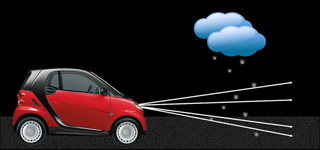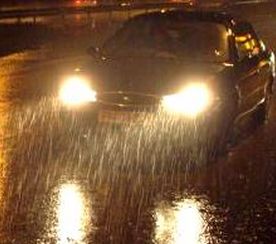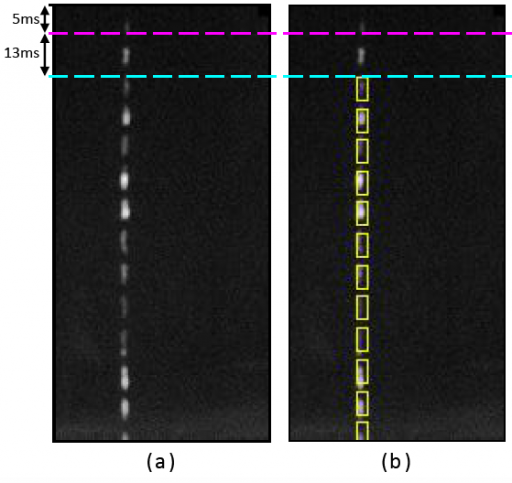Smart headlight system sees through rain and snow
July 10, 2012

The proposed "smart headlight" system deactivates only those light rays that intersect particles such as raindrops, snowflakes, and hailstones, diminishing the visual effect of precipitation (credit: CMU)
A new “smart headlight” system invented by researchers at Carnegie Mellon University’s Robotics Institute can improve visibility when driving at night in a rainstorm or snowstorm.
By constantly redirecting light to shine between particles of precipitation, the system prevents the distracting and sometimes dangerous glare that occurs when headlight beams are reflected by precipitation back toward the driver.
“If you’re driving in a thunderstorm, the smart headlights will make it seem like it’s a drizzle,” said Srinivasa Narasimhan, associate professor of robotics.
How it works

At night, illuminated rain or snow appears as a bright flickering (distracting) pattern that reduces driver visibility (credit: CMU)
The system uses a camera to track the motion of raindrops and snowflakes and then applies a computer algorithm to predict where those particles will be just a few milliseconds later.
The light projection system then adjusts to deactivate light beams that would otherwise illuminate the particles in their predicted positions. “A human eye will not be able to see that flicker of the headlights,” Narasimhan said.
“And because the precipitation particles aren’t being illuminated, the driver won’t see the rain or snow either.” To people, rain can appear as elongated streaks that seem to fill the air. To high-speed cameras, however, rain consists of sparsely spaced, discrete drops.
That leaves plenty of space between the drops where light can be effectively distributed if the system can respond rapidly, Narasimhan said.

Predicting and avoiding illumination of a single drop. In this experiment, the drop is first imaged with 5ms camera exposure time (shown above magenta dashed line). The system latency is shown above the cyan dashed line. Images shown are composites of the 14 frames needed for the drop to traverse the field of view (FOV). Since the experiments are repeatable, the ground-truth image on the left shows drops illuminated throughout the entire FOV (a). The drop is falling with near constant velocity at 16 pixels per frame, so prediction is straightforward (shown as yellow boxes) (b). The light would be projected during the dark frames. (Credit: CMU)
Lab tests
In their lab tests, Narasimhan and his research team demonstrated that their system could detect raindrops, predict their movement, and adjust a light projector accordingly in 13 milliseconds.
At low speeds, such a system could eliminate 70 to 80 percent of visible rain during a heavy storm, while losing only 5 or 6 percent of the light from the headlamp.
To operate at highway speeds and to work effectively in snow and hail, the system’s response will need to be reduced to just a few milliseconds, Narasimhan said.
The lab tests have demonstrated the feasibility of the system, however, and the researchers are confident that the speed of the system can be boosted. The test apparatus, for instance, couples a camera with an off-the-shelf DLP projector.
Getting on the road
Roadworthy systems likely would be based on arrays of light-emitting diode (LED) light sources in which individual elements could be turned on or off, depending on the location of raindrops. New LED technology could make it possible to combine LED light sources with image sensors on a single chip, enabling high-speed operation at low cost.
Narasimhan’s team is now engineering a more compact version of the smart headlight that in coming years could be installed in a car for road testing. Though a smart headlight system will never be able to eliminate all precipitation from the driver’s field of view, simply reducing the amount of reflection and distortion caused by precipitation can substantially improve visibility and reduce driver distraction.
Another benefit is that the system also can detect oncoming cars and direct the headlight beams away from the eyes of those drivers, eliminating the need to shift from high to low beams.
“One good thing is that the system will not fail in a catastrophic way,” Narasimhan said. “If it fails, it is just a normal headlight.”
This research was sponsored by the Office of Naval Research, the National Science Foundation, the Samsung Advanced Institute of Technology and Intel Corp. The Robotics Institute is part of Carnegie Mellon’s School of Computer Science.